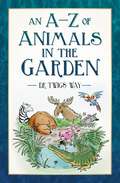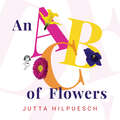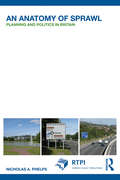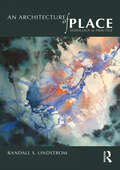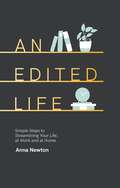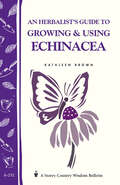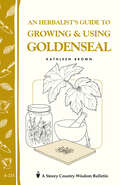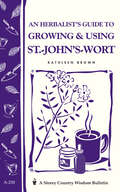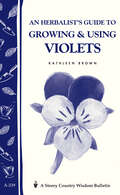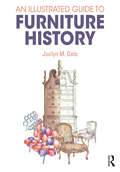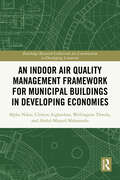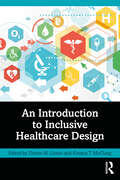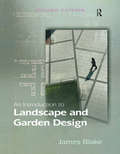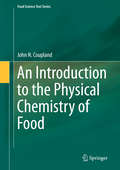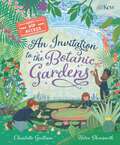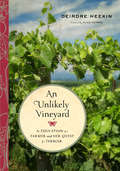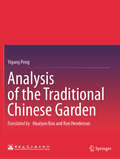- Table View
- List View
Amy Butler's Blossom
by Amy ButlerAmy Butler's Blossom magazine is a biannual collection of everything that inspires her: page after page of photographs from her travels to spiritual locales such as Morocco and Sedona; meditative articles from like-minded designers, artists, and life coaches; the signature designs and textiles that she creates from these inspirations; plus her ongoing exploration of positive and joyful living. Now available in print for the first time, this irresistible look-book compiles the first two issues of the magazine. Brimming with photographs, fashion, art, patterns, and written pieces that reflect Amy's unique philosophy of life and style, Blossom will capture the imagination of anyone in search of beauty and meaning.
Amy Butler's Blossom: Create Love - Express Beauty - Be Kind
by Amy ButlerAmy Butler's Blossom magazine is a biannual collection of everything that inspires her: page after page of photographs from her travels to spiritual locales such as Morocco and Sedona; meditative articles from like-minded designers, artists, and life coaches; the signature designs and textiles that she creates from these inspirations; plus her ongoing exploration of positive and joyful living. Now available in print for the first time, this irresistible look-book compiles the first two issues of the magazine. Brimming with photographs, fashion, art, patterns, and written pieces that reflect Amy's unique philosophy of life and style, Blossom will capture the imagination of anyone in search of beauty and meaning.
An A-Z of Animals in the Garden
by Twigs WayA quirky look at some of the most unusual garden animals ever kept in Britain, from crocodiles to wombats Perhaps one of the less known facts about the Pre-Raphaelite artist Dante Gabriel Rossetti is that he kept wombats in his garden at Cheyne Walk, London, to whom he and Christina addressed poetry (he also kept zebu - a type of cattle). This is just one of the stories in this entertaining book, which brings together two great British pastimes: animal husbandry and the garden. Taking the reader on a journey from the armadillos owned by merchants in the City of London in the eighteenth century and nourished on garden earthworms, to Queen Charlotte's zebra, which was accommodated close to her house at Buckingham Gate and renowned for its nicotine-fueled filthy temper, here are quirky tales of animals in the garden through the centuries.
An ABC of Flowers
by Jutta Hilpuesch"A vividly photographed ABC book with a clean, sophisticated aesthetic." --Publishers WeeklyStep into the garden and learn your ABC's with this colorful feast for the eyes! From asters and daisies to roses and sunflowers, An ABC of Flowers is a colorful burst from the garden that will have little hands eager to grab. Filled with gorgeous photo illustrations, bold colors, and clever line art featuring a miniature-sized girl named Amelie, toddlers will laugh and be mezmerized by the book's vibrant pages.Perfect for the youngest readers learning their ABC's!
An Anatomy of Sprawl: Planning and Politics in Britain (RTPI Library Series)
by Nicholas A. PhelpsDespite the combined efforts of British planners, politicians, the public and interest groups, the ‘Solent City’ stands as one of a number of instances of a peculiar instance of urban sprawl – muted, and slow to emerge – yet produced paradoxically by very strong interests in promoting conservation and restraint. This unique and valuable case study, while focusing on the planning and development of South Hampshire in particular, enables an in-depth study of the issues surrounding planning strategies with regards to growing populations.
An Architecture of Parts: Architects, Building Workers, And Industrialization In Britain, 1940-1970 (Routledge Research in Architecture)
by Christine WallThis book is unique in describing the history of post war reconstruction from an entirely new perspective by focusing on the changing relationship between architects and building workers. It considers individual, as well as collective, interactions with technical change and in doing so brings together, for the first time, an extraordinary range of sources including technical archives, oral history and visual material to describe the construction process both during and in the decades after the war. It focuses on the social aspects of production and the changes in working life for architects and building workers with increasing industrialization, in particular analysing the effect on the building process of introducing dimensionally co-ordinated components. Both architects and building workers have been accused of creating a built environment now popularly discredited: architects responsible for poor design and building workers for poor workmanship. However, many of the structures and ideas underpinning this period of rapid change were revolutionary in their commitment to a complete transformation of the building process. An Architecture of Parts adds to the growing literature on changes in the building world during and immediately after the Second World War. It is significant, both empirically and historically, in its examination of the ideas, technology and relationships that fired industrialization of the building process in mid-century Britain.
An Architecture of Place: Topology in Practice
by Randall S. LindstromChallenging mainstream architecture’s understandings of place, this book offers an illuminating clarification that allows the idea’s centrality, in all aspects of everyday design thinking, to be rediscovered or considered for the first time.Rigorous but not dense, practical but not trivialising, the book unfolds on three fronts. First, it clearly frames the pertinent aspects of topology—the philosophy of place—importantly differentiating two concepts that architecture regularly conflates: place and space. Second, it rejects the ubiquitous notion that architecture “makes place” and, instead, reasons that place is what makes architecture and the built environment possible; that place “calls” for and to architecture; and that architecture is thus invited to “listen” and respond. Finally, it turns to the matter of designing responses that result not just in more places of architecture (demanding little of design), nor merely in architecture with some “sense of place” (demanding little more), but, rising above those, responses that constitute an architecture of place (demanding the greatest vigilance but offering the utmost freedom).Opening up a term regarded as so common that its meaning is seldom considered, the author reveals the actual depth and richness of place, its innateness to architecture, and its essentiality to practitioners, clients, educators, and students—including those in all spatial disciplines.
An Ear to the Ground: Understanding Your Garden
by Ken ThompsonHow did plants get to be the way they are? Why do they have pretty flowers? How different would things have been if the wrong kind of pollinators had got the upper hand? Why are Latin names so complicated, and why Latin anyway? Why is a weed-free lawn an ecological impossibility?This entertaining book gives the answers to these questions and many more. It shows how a little botanical knowledge can bring not just better results but peace of mind, and that losing sleep over such traditional gardening bogeys as weeds, pests and pruning is not necessarily the best course. In this new edition Ken Thompson grabs the opportunity to explain why any old plant will do for companion planting - but also that it can do as much harm as good - and why planting by the moon is complete and utter nonsense.
An Edited Life: Simple Steps to Streamlining your Life, at Work and at Home
by Anna NewtonDeclutter every aspect of your life - from your wardrobe, exercise schedule and food budget to your phone, bookshelves and beauty regime - with this realistic guide to getting neat and keeping things that way.Anna Newton is just trying to balance work, her friends, her family, her husband Mark, a growing handbag habit and a love for takeaway pizza. Over the past 8 years of running the blog and corresponding YouTube Chanel ‘The Anna Edit’, she’s grown a loyal viewership who tune in for her weekly videos on everything from house renovations to the best summer foundation.Anna is a typical Virgo – she loves being organised. She’s Marie Kondo’d her house, nearly throwing away her TV remote in the process. She’s waved goodbye to her things with Fumio Sasaki. She’s minimized and bullet-journalled her schedules down to the finest detail. Along the way, she’s realised something key: there’s no one prescription for an organized life, a tidy home and calm mind. Instead, it’s all about editing.Learn how to edit your home, calendar, exercise regime, social life, me-time, wardrobe, household budget, digital detox, beauty routine and office space. It's about how to utilise your time and spend more of it doing what makes you happy.
An Encyclopedia of Gardening for Colored Children
by Jamaica KincaidA unique collaboration from two of America’s leading artists that explores the fascinating and hidden history of the plant world.In this witty, deeply original book, the renowned novelist Jamaica Kincaid offers an ABC of the plants that define our world and reveals the often brutal history behind them.Kara Walker, one of America’s greatest visual artists, illustrates each entry with provocative, brilliant, enthralling, many-layered watercolors.There has never been a book like An Encyclopedia of Gardening for Colored Children—so inventive, surprising, and telling about what our gardens reveal.
An Herbalist's Guide to Growing & Using Echinacea: A Storey Country Wisdom Bulletin (Storey Country Wisdom Bulletin Ser.)
by Kathleen BrownSince 1973, Storey's Country Wisdom Bulletins have offered practical, hands-on instructions designed to help readers master dozens of country living skills quickly and easily. There are now more than 170 titles in this series, and their remarkable popularity reflects the common desire of country and city dwellers alike to cultivate personal independence in everyday life.
An Herbalist's Guide to Growing & Using Goldenseal: Storey's Country Wisdom Bulletin A-233 (Storey Country Wisdom Bulletin Ser.)
by Kathleen BrownSince 1973, Storey's Country Wisdom Bulletins have offered practical, hands-on instructions designed to help readers master dozens of country living skills quickly and easily. There are now more than 170 titles in this series, and their remarkable popularity reflects the common desire of country and city dwellers alike to cultivate personal independence in everyday life.
An Herbalist's Guide to Growing & Using St.-John's-Wort: Storey Country Wisdom Bulletin A-230 (Storey Country Wisdom Bulletin Ser.)
by Kathleen BrownSince 1973, Storey's Country Wisdom Bulletins have offered practical, hands-on instructions designed to help readers master dozens of country living skills quickly and easily. <P><P>There are now more than 170 titles in this series, and their remarkable popularity reflects the common desire of country and city dwellers alike to cultivate personal independence in everyday life.
An Herbalist's Guide to Growing & Using Violets: Storey Country Wisdom Bulletin A. 239
by Kathleen BrownSince 1973, Storey's Country Wisdom Bulletins have offered practical, hands-on instructions designed to help readers master dozens of country living skills quickly and easily. There are now more than 170 titles in this series, and their remarkable popularity reflects the common desire of country and city dwellers alike to cultivate personal independence in everyday life.
An Illustrated Guide to Furniture History
by Joclyn M. OatsAn Illustrated Guide to Furniture History provides upper-level students and instructors with an alternative visual analytical approach to learning about furniture history from Antiquity to Postmodernism. Following an immersive teaching model, it presents a Nine-Step Methodology to help students strengthen their visual literacy and quickly acquire subject area knowledge. Moving chronologically through key periods in furniture history and interior design, such as the Renaissance, the Arts and Crafts Movement, and Modernism, it traverses Europe to America to present a comprehensive foundational guide to the history of furniture design. Part I addresses furniture within the context of the built environment, with chapters exploring the historical perspective, construction principles, and the categorization of furniture. In Part II, the author visually depicts the structural organization of the methodological process, a three-category framework: History, Aesthetics, and Visual Notes. The chapters in this part prepare the reader for the visual analysis that will occur in the final section of the book. The book is lavishly illustrated in full color with over 300 images to reinforce visual learning and notation. A must-have reference and study guide for students in industrial and product design, interior design, and architecture.
An Indoor Air Quality Management Framework for Municipal Buildings in Developing Economies (Routledge Research Collections for Construction in Developing Countries)
by Clinton Ohis Aigbavboa Wellington Didibhuku Thwala Abdul-Majeed Mahamadu Mpho NdouThis book delves into the pivotal issue of Indoor Air Quality (IAQ) management in municipal buildings within developing economies, addressing a pressing need in today’s digital age, where individuals spend over 70% of their time indoors. With a strong focus on enhancing environmental quality, this book presents theoretical frameworks and practical recommendations designed explicitly for stakeholders in the higher education sector, encompassing both public and private institutions.As institutions strive to improve their learning environments, this book aligns with global Sustainable Development Goals (SDGs), highlighting the vital connection between effective IAQ management and the health and well-being of the institutional community, including students and staff members. It provides a comprehensive framework that advocates for improved IAQ management and emphasises the importance of quality education and lifelong learning.Furthermore, this book serves as a valuable resource for green building regulatory bodies, ensuring adherence to best practices in IAQ management within municipal buildings. By providing actionable strategies grounded on recent literature, the book is an essential guide for researchers and policymakers seeking to navigate the theoretical and empirical dimensions of IAQ management. Moreover, this book asserts that enhancing IAQ is necessary not only for regulatory compliance and community well-being but also as a vital investment in the academic and operational success of municipal buildings in developing economies.
An Integrated Approach to Home Security and Safety Systems
by Sonali Goyal Neera BatraThis book provides an integrated solution for security and safety in the home, covering both assistance in health monitoring and safety from strangers/intruders who want to enter the home with harmful intentions. It defines a system whereby recognition of a person/stranger at the door is done using three modules: Face Recognition, Voice Recognition and Similarity Index. These three modules are taken together to provide a percentage likelihood that the individual is in the "known" or "unknown" category. The system can also continuously monitor the health parameters of a vulnerable person living alone at home and aid them in calling for help in an emergency. The authors have analyzed a number of existing biometric techniques to provide security for an individual living alone at home. These biometric techniques have been tested using MATLAB® image processing and signal processing toolboxes, and results have been calculated on the basis of recognition rate. A major contribution in providing security is a hybrid algorithm proposed by the author named PICA, which combines features of both PCA (Principle Component Analysis) and ICA (Independent Component Analysis) algorithms. This hybrid approach gives better performance recognition than either system alone. The second proposed hybrid algorithm for voice recognition is named as a MFRASTA algorithm by combining features of MFCC (Mel Frequency Cepstral Coefficient) and RASTA-PLP (RelAtive SpecTrA-Perceptual Linear Prediction) algorithm. After performing experiments, results are collected on the basis of recognition rate. The authors have also proposed a third technique named as a Similarity Index to provide trust-based security for an individual. This technique is text independent in which a person is recognized by pronunciation, frequency, tone, pitch, etc., irrespective of the content spoken by the person. By combining these three techniques, a high recognition rate is provided to the person at the door and high security to the individual living independently at home. In the final contribution, the authors have proposed a fingertip-based application for health monitoring by using the concept of sensors. This application is developed using iPhone 6’s camera. When a person puts their fingertip on a camera lens, with the help of brightness of the skin, the person’s heartbeat will be monitored. This is possible even with a low-quality camera. In case of any emergency, text messages will be sent to the family members of the individual living alone by using 3G Dongle and MATLAB tool. Results show that the proposed work outperforms all the existing techniques used in face recognition, voice recognition, and health monitoring alone.
An Integrative Approach to Successional Dynamics
by Meiners, Scott J. and Pickett, Steward T. A. and Cadenasso, Mary L. Scott J. Meiners Pickett, Steward T. A. Mary L. CadenassoMuch of what is considered conventional wisdom about succession is not as clear cut as it is generally believed. Yet, the importance of succession in ecology is undisputed since it offers a real insight into the dynamics and structure of all plant communities. Part monograph and part conceptual treatise, An Integrative Approach to Successional Dynamics presents a unifying conceptual framework for dynamic plant communities and uses a unique long-term data set to explore the utility of that framework. The fourteen chapters, each written in a nontechnical style and accompanied by numerous illustrations and examples, cover diverse aspects of succession, including: community, population and disturbance dynamics, diversity, community assembly, heterogeneity, functional ecology and biological invasion. This unique text will be a great source of reference for researchers and graduate students in ecology and plant biology and others with an interest in the subject.
An Introduction to Inclusive Healthcare Design
by Denise M. Linton Kiwana T. McClungAn Introduction to Inclusive Healthcare Design is a comprehensive guide to the design and facilitation of safe, healthy, equitable, and inclusive healthcare settings across a variety of scales. The book informs healthcare professionals, healthcare administrators, planners, designers in the healthcare sector, design students, and faculty about best practices and considerations for inclusive design.The primary theme for the book is design for all – considering the design of healthcare spaces through the lenses of inclusivity and social equity. Part 1 presents the reader with an overview of the variety of locations and types of healthcare settings. Part 2 provides a comprehensive overview of the principles of equitable and inclusive healthcare design and considers how these principles can be applied to the range of settings laid out in Part 1. The authors consider inclusivity-supportive infrastructure in primary and ancillary spaces within healthcare settings. Part 3 envisions the future of inclusive healthcare design, considering the integration of virtual reality and artificial intelligence, as well as addressing the ever more relevant issue of healthcare provision in settings at risk of natural disasters.
An Introduction to Landscape and Garden Design
by James BlakeHow do you design a landscape book suitable for its intended uses? How can the natural qualities of a landscape be enhanced with new features and focal points? How can you make pedestrians stay on the footpath? What kind of plant, path or wall should you put where, and what sort of contract should you choose for your client's contractor? This refreshingly down-to-earth introduction to the vast subject of landscape design and construction answers all these questions, guiding new students through the many facets of professional practice and welding together the artistic, legal, financial, environmental and management issues which can seem so dauntingly disconnected. Illustrated with original drawings, photographs, sample plans and facsimiles, including a new colour plate section, this readable classic has been fully revised and updated throughout. It opens with a completely new chapter which explains design and aesthetic principles, explores the history of our relationship to landscape, and shows how design principles can be applied to influence reactions to the finished site. The author then considers different elements of hard landscape and their relative merits in different situations. The soft landscape section includes coverage of the effects of mass and form, natural and abstract planting, and the difficult subject of plant selection. A step-by-step guide through all the stages of managing a project, from initial discussions with clients, site inspection, surveying and quoting, through tendering, contracting, contractual agreements, development from concept design to final plans and drawings, as well as maintenance, now includes the current information on CDM regulations and provides readers with a plain-speaking reference on client management and contractual administration. Added to the guide to drawing and lettering is an extensive section on computer-aided design. A bibliography and list of useful organization are also included.
An Introduction to Spatial Planning in the Netherlands
by Thomas Hartmann Patrick WitteThis book provides an introduction to spatial planning in the Netherlands. It explores the academic underpinnings of the discipline and its practical implications, making use of insights on planning practices from the Netherlands. As an academic book with relevance for spatial planning teaching and practice, the relation between planning practice and planning as an academic discipline are discussed. A key analytical concept is introduced to discuss the different dimensions of planning: the planning triangle. This framework helps to bridging the strategic and conceptual elements of planning with its realization. The object, process and context of planning and its relations are discussed. The core of the academic discipline and profession of spatial planning entails looking (far) into the future, stimulating discussion, formulating a desired future direction through an informal and collective planning process and then formalizing and placing current action into that future perspective. In that sense, spatial planning can be understood as the strategic organisation of hopes and expectations. As a study book it is suitable for students of planning at various universities, but also for students in higher professional education. For those involved in the professional field of spatial planning, this book offers a sound foundation.
An Introduction to the Physical Chemistry of Food (Food Science Text Series)
by John N. CouplandFamiliar combinations of ingredients and processing make the structures that give food its properties. For example in ice cream, the emulsifiers and proteins stabilize partly crystalline milk fat as an emulsion, freezing (crystallization) of some of the water gives the product its hardness and polysaccharide stabilizers keep it smooth. Why different recipes work as they do is largely governed by the rules of physical chemistry. This textbook introduces the physical chemistry essential to understanding the behavior of foods. Starting with the simplest model of molecules attracting and repelling one another while being moved by the randomizing effect of heat, the laws of thermodynamics are used to derive important properties of foods such as flavor binding and water activity. Most foods contain multiple phases and the same molecular model is used to understand phase diagrams, phase separation and the properties of surfaces. The remaining chapters focus on the formation and properties of specific structures in foods - crystals, polymers, dispersions and gels. Only a basic understanding of food science is needed, and no mathematics or chemistry beyond the introductory college courses is required. At all stages, examples from the primary literature are used to illustrate the text and to highlight the practical applications of physical chemistry in food science.
An Invitation to the Botanic Gardens
by Charlotte GuillainGrab your very own VIP access pass and explore the incredible Botanic Gardens.Have you ever wondered what goes on at the Botanic Gardens? It's not all planting and pruning. In fact, the team have a planet-saving mission on their hands – and you can help. Step off the path and follow the Garden crew who will show you behind the scenes of the Botanic Gardens with your very own access-all-areas invitation.Find out how scientists research plants that can cure diseases, watch workers wading in the waterlily pond, and discover the secrets of seeds. Find out why samples of rare and endangered plants are stored in the Herbarium and leave no leaf unturned in the tropical glasshouse. Discover insect-eating plants, zombie fungus, plants pretending to be pebbles, and more.As you turn the pages you'll learn about the importance of insects, the impact of climate change and how plants grow. With beautiful, lush illustrations, you'll discover more wonderful details each time you return to the gardens.Three large gatefolds open up to reveal even more information.
An Unlikely Vineyard
by Alice Feiring Deirdre HeekinAn Unlikely Vineyard tells the evolutionary story of Deirdre Heekin's farm from overgrown fields to a fertile, productive, and beautiful landscape that melds with its natural environment. Is it possible to capture landscape in a bottle? To express its terroir, its essence of place--geology, geography, climate, and soil--as well as the skill of the winegrower? That's what Heekin and her chef/husband, Caleb Barber, set out to accomplish on their tiny, eight-acre hillside farm and vineyard in Vermont. But An Unlikely Vineyard involves much more. It also presents, through the example of their farming journey and winegrowing endeavors, an impressive amount of information on how to think about almost every aspect of gardening: from composting to trellising; from cider and perry making to growing old garden roses, keeping bees, and raising livestock; from pruning (or not) to dealing naturally with pests and diseases. Challenged by cold winters, wet summers, and other factors, Deirdre and Caleb set about to grow not only a vineyard, but an orchard of heirloom apples, pears, and plums, as well as gardens filled with vegetables, herbs, roses, and wildflowers destined for their own table and for the kitchen of their small restaurant. They wanted to create, or rediscover, a sense of place, and to grow food naturally using the philosophy and techniques gleaned from organic gardening, permaculture, and biodynamic farming. Accompanied throughout by lush photos, this gentle narrative will appeal to anyone who loves food, farms, and living well.
Analysis of the Traditional Chinese Garden
by Yigang PengAnalysis of the Traditional Chinese Garden is a seminal resource for the spatial principles and techniques that shape traditional Chinese gardens. It is a richly illustrated resource for historians, theorists, garden designers, landscape architects, architects and anyone interested in the design of these world renowned gardens with 106 pages of hand-drawn sketches by the author that vividly portray the intricacies and subtleties of traditional Chinese gardens. The book is widely known in China as a primary text for analysis of the gardens and was recognized with the inaugural National Excellent Architectural Book Award in 1990 and, since its debut in China in 1986, has garnered immense popularity and acclaim with 50 reprints and a total print run of 150,000 copies.


